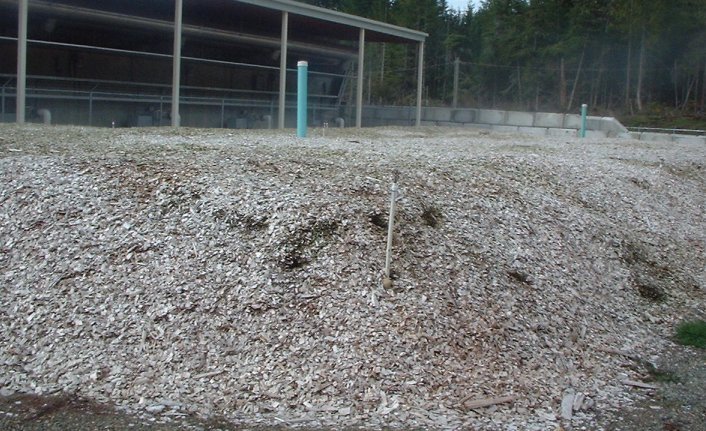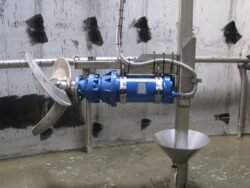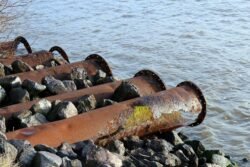
Trickling Filters in Wastewater Treatment: An Efficient Biofiltration Solution

Trickling filters are a well-established method for treating wastewater, offering a reliable way to reduce the amount of organic material before it is returned to the environment or reused. These systems involve a biological process where microorganisms attached to a medium break down pollutants in the water. Their simple yet effective design makes them suitable for a variety of applications ranging from municipal sewage treatment to industrial waste management.
The basic principle behind trickling filters is to expose wastewater to a large surface area where bacteria and other microorganisms reside. As the water trickles over the media, typically rocks or specially designed plastic materials, the microorganisms consume the organic matter, thereby cleaning the water. These filters are not only an essential component of many wastewater treatment plants but also represent a sustainable option that can be adapted to different scales and conditions. Their operation is relatively straightforward, requiring minimal energy input compared to other treatment processes like activated sludge systems.
Key Takeaways
- Trickling filters utilize microorganisms to degrade organic material in wastewater naturally.
- They provide a cost-effective and energy-efficient treatment option for various applications.
- Ongoing maintenance and proper design are critical for optimal performance and longevity.
Principles of Trickling Filters
Trickling filters stand as a robust solution in wastewater treatment, harnessing biological processes to efficiently remove organic matter. They leverage microbial action on a fixed medium to break down waste, ensuring an effective purification process.
Biological Film Growth
The essence of trickling filter efficacy lies in the biological film that develops on the medium’s surface. This film, consisting of a diverse consortium of microorganisms, clings to the medium and forms a living layer. As wastewater passes over this biofilm, microbes consume organic material, thus purifying the water. The thickness and type of biofilm are influenced by factors such as nutrient load and the nature of the wastewater being treated.
Wastewater Distribution
Wastewater distribution across the trickling filter is a critical aspect of its design. A system known as the rotating arm distributor typically applies the wastewater evenly over the filter media. The even distribution is necessary to ensure all parts of the biofilm are adequately exposed to the wastewater nutrients, maximizing the treatment process efficiency.
Aeration and Ventilation
Trickling filters inherently ensure aeration, a vital component for aerobic microbial activity. Their open structure permits air to circulate freely, supplying oxygen to the biofilm. Ventilation maintains aerobic conditions and helps disperse gases produced during treatment, such as carbon dioxide and any potential odors. Aerobic conditions are crucial for high treatment efficiency and for maintaining an active microbial population within the filter.
Design and Construction
In the realm of wastewater treatment, trickling filters stand out for their efficiency and straightforward design. They facilitate the breakdown of organic matter through a biological process, which is contingent on the characteristics of the media used and the structural integrity of the system.
Media Types and Characteristics
The media in a trickling filter is crucial; it provides a surface for microorganisms to attach and form a biofilm. Media types vary from conventional rocks to specially designed plastic media. Characteristics such as surface area, porosity, and durability are essential.
- Rocks: Generally inexpensive but with a lower surface area-to-volume ratio.
- Plastic media: Higher in cost, yet provide a greater surface area and promote efficient biofilm formation.
Both media types must ensure adequate air circulation for optimal microbial activity, and their selection directly impacts the hydraulic loading rates and treatment efficiency.
Structural Components
The structural components of a trickling filter include the base or underdrain system, the media bed, and a distribution system to apply wastewater evenly over the media.
- Base/Underdrain System: Supports the media, collects treated water, and allows for airflow. It often includes a layer of gravel and a network of perforated pipes.
- Media Bed: Stacked above the underdrain, this is where the treatment takes place. Height and diameter are designed based on the desired treatment capacity.
- Distribution System: Typically a rotating arm that distributes wastewater atop the media bed. This system can be designed to allow for both full and partial distribution.
Robust construction ensures the longevity and reliability of the trickling filter system, which often operates continuously for extended periods.
Operation and Maintenance
Effective operation and maintenance of Trickling Filters are fundamental to their performance in wastewater treatment. This encompasses ensuring appropriate flow regulation, diligent monitoring, and control, alongside consistent cleaning and upkeep.
Flow Regulation
Trickling Filters rely on the controlled distribution of wastewater over the microbial media. The flow must be consistent and even, as this prevents channeling and ensures optimal contact between the wastewater and the biofilm. Flow rate adjustment might be necessary to accommodate daily fluctuations or varying wastewater characteristics.
Monitoring and Control
Routine monitoring of system parameters such as pH, temperature, and biochemical oxygen demand (BOD) is crucial. Control mechanisms must be frequently checked and calibrated to ensure that the microorganisms in the Trickling Filter remain within their effective operating range. Online sensors and remote monitoring can facilitate real-time adjustments and predictive maintenance.
Cleaning and Upkeep
The integrity of the media in Trickling Filters must be preserved through regular cleaning to prevent clogging and to maintain surface area for biofilm growth. Raking or air flushing can remove excess biomass and inorganic solids accumulating over time. Periodic inspections can help identify wear and tear on mechanical components, such as rotary distributors, to preemptively address maintenance needs.
Performance and Efficiency
Trickling filters offer a reliable means of wastewater treatment, efficiently reducing organic content through biological means. Their performance hinges on the intricate interactions between microorganisms and wastewater constituents.
Removal of Contaminants
Trickling filters excel in the removal of organic matter, thanks to a robust population of microorganisms that reside on the filter media. These microorganisms degrade organic pollutants, transforming them into more stable compounds. As detailed in an EPA fact sheet, trickling filters are adept at breaking down complex organic material into simpler, less harmful byproducts.
- Nitrogen removal: These systems can also facilitate the partial nitrification of ammonia to nitrate.
- Reduction in biochemical oxygen demand (BOD): Typically, a well-operated trickling filter achieves a significant reduction in BOD, which is a critical measure of the contaminant load in wastewater.
Measurement of Treatment Efficacy
To determine the performance of a trickling filter system, specific parameters are evaluated. The primary metrics include:
- Biological oxygen demand (BOD) reduction: A key indicator of the effectiveness of organic pollutant removal.
- Total suspended solids (TSS): Assessments of TSS levels post-treatment offer insights into the clarity and quality of the effluent.
The EPA’s Municipal Wastewater and Sludge Treatment document elaborates on the process monitoring techniques used to assess and maintain the efficacy of wastewater treatment systems, including trickling filters. These measurements are essential for water quality compliance and ensuring the treatment process adheres to environmental standards.
Applications and Case Studies
Trickling filters represent an established method of treating wastewater. This section explores specific instances of their use in municipal and industrial settings.
Municipal Wastewater Treatment
Municipal wastewater treatment facilities often employ trickling filters for their cost-effectiveness and efficiency in biological waste treatment. For example, the Lake George WWTP implements a system that includes equalization, clarification, and trickling filters to handle varying demand, ranging from 1.3 MGD in the summer to 0.5-0.6 MGD during winter. This system showcases how trickling filters can adapt to different seasonal flows, providing consistent treatment quality throughout the year.
Industrial Wastewater Solutions
In the industrial sector, trickling filters facilitate the removal of organic pollutants while coping with high-strength wastewater streams. The approach is used when industries require solutions for waste treatment without the large spatial requirements of traditional methods. As outlined by the U.S. Environmental Protection Agency, membrane bioreactor systems, which can include trickling filters, allow for improved treatment performance in smaller spaces, representing a major advantage for industrial applications.
Environmental Impact and Sustainability
Trickling filters, as a biological treatment method for wastewater, offer several environmental benefits and lend themselves to sustainable practices. They function by allowing microorganisms to break down organic material in wastewater, which impacts both energy usage and resource recovery.
Energy Consumption
Trickling filters are energy-efficient in operation compared to other wastewater treatment methods. They require less energy because they rely on the passive flow of wastewater over microbial films that degrade organic pollutants. Unlike activated sludge systems, trickling filters do not require continuous aeration, which results in lower electricity demands.
Resource Recovery
A key sustainable advantage of trickling filters is their ability to facilitate resource recovery. As microorganisms break down waste, they can produce byproducts like methane, which can be captured and utilized for energy generation. Additionally, the treated effluent can be repurposed for non-potable applications, and excess biomass can be used as a soil conditioner, promoting a circular economy.
Regulations and Standards
In the domain of wastewater treatment, Trickling Filters are subject to stringent regulatory standards to ensure they effectively remove organic matter from wastewater. These regulations are aimed at protecting water quality and public health.
International Guidelines
Internationally, guidelines for Trickling Filters are established to maintain the quality of discharged water. They often specify the permissible levels of biochemical oxygen demand (BOD5), total suspended solids (TSS), and pH levels in the effluent. For example, the World Health Organization (WHO) provides recommendations on wastewater safety, which may encompass guidelines for trickling filter technology depending on the region.
Compliance and Reporting
Wastewater facilities utilizing Trickling Filters must adhere to local and national regulations that govern reporting and compliance. In the United States, the Environmental Protection Agency (EPA) sets secondary treatment standards for publicly owned treatment works (POTWs), including those using Trickling Filters. Facilities are required to regularly monitor treatment effectiveness and report their findings to maintain compliance with the Clean Water Act. Failure to meet these standards can result in legal and financial repercussions.
Advancements and Innovations
Recent advancements in trickling filter technology have focused on enhancing efficiency and treatment outcomes. Innovations in materials and biofiltration methods have led to improved removal rates of pollutants and more resilient systems in wastewater management.
Technological Developments
Trickling filters have undergone several technological developments aimed at optimizing the wastewater treatment process. Modern trickling filters now incorporate:
- Structured Media: Advances in media design allow for increased surface area, promoting more effective microbial growth and pollutant removal. The transition from traditional stones to engineered plastic media has also reduced the system’s weight and improved airflow.
- Flow Distribution: More precise flow distribution mechanisms ensure even wastewater distribution over the filter media, which is critical for maximizing treatment efficiency and avoiding channeling.
- Monitoring Systems: Incorporation of real-time monitoring systems utilizing sensors and control units that enable adjustments to be made in response to varying wastewater characteristics and flow rates, ensuring optimal performance.
Emerging Research
Emerging research in the field of trickling filters is unveiling promising methods to further increase their efficacy. Notable research findings include:
- Nitrous Oxide Removal: Studies show that modifying operational conditions can enhance the removal of nitrous oxide, a potent greenhouse gas, from wastewater.
- Hybrid Systems: Research is also pointing towards hybrid systems that combine trickling filters with other treatment methods, such as activated sludge processes, to handle different types of contaminants more effectively.
By embracing these advancements and exploring new research, trickling filters continue to be a key component in the evolution of wastewater treatment technology.
Challenges and Considerations
Trickling filters are a pivotal component in wastewater treatment; however, when deploying them, one must carefully consider their operational limitations and the economic factors involved to ensure efficiency and sustainability.
Operational Limitations
Trickling filters, though effective for treating wastewater, possess certain operational limitations. They may face challenges with hydraulic loading rates and air ventilation, both of which are crucial for maintaining the biofilm that degrades pollutants. These systems have a threshold for organic loading, and an influx beyond their capacity can lead to clogging and channeling—where water bypasses the filter media and reduces treatment efficiency. Additionally, temperature variations can influence the microbial activity within the filter, necessitating climate considerations in the design phase.
Economic Factors
From an economic standpoint, the initial capital outlay for constructing a trickling filter system can be substantial. It’s imperative to consider not only the construction costs but also the long-term operation and maintenance expenses. Regular backwashing and media replacement add to operational costs. Economic considerations also extend to scalability and adaptability, with smaller systems facing higher per-unit costs. However, the economic viability can improve over time as advances in materials and design lead to cost-effective solutions for wastewater treatment.
Frequently Asked Questions
How do trickling filters function in the treatment of wastewater?
Trickling filters treat wastewater by allowing it to flow over a bed of media, where a biofilm of microorganisms degrades organic matter. Oxygen, essential for this process, is supplied through the air circulating through the media.
What distinguishes trickling filters from activated sludge processes in wastewater treatment?
Trickling filters rely on a fixed-bed system where microorganisms grow on media, while activated sludge processes use a suspended-growth system where microorganisms are mixed with wastewater. This leads to differences in operational requirements and sludge production.
What are the primary components of a trickling filter system?
A trickling filter system primarily consists of a bed of media to support microorganism growth, distribution arms or nozzles to spread wastewater, and under-drains to collect treated water. These components work together to ensure efficient wastewater treatment.
Can trickling filters be used for both primary and secondary wastewater treatment?
Trickling filters are typically used for secondary wastewater treatment, where they remove organic matter after primary treatment. However, depending on the design and operational strategy, they can also be part of the primary treatment process.
What are the main benefits and possible drawbacks of using trickling filters for wastewater management?
The benefits of trickling filters include their low energy requirements, simplicity, and durability. Possible drawbacks may involve clogging, the requirement of periodic media replacement, and less control over the treatment process compared to more advanced methods.
How do different types of trickling filters compare in terms of effectiveness and application?
Different types of trickling filters, like standard rate filters and high-rate filters, vary in loading rates, hydraulic characteristics, and type of media used. These differences dictate their effectiveness and suitability for specific wastewater treatment applications.

